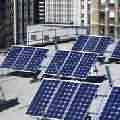|
記者:柏尼‧費屈洛維玆-羅柏特
1996年,奧勒岡州賽勒姆成為全美第一個完全採用再生能源電力的城市。該市已有83%的電力來自水力發電;其餘的13%電力原本是利用石化燃料和核能發電,後來也全部改採邦納維爾電力管理局所提供的風能。
加州奧克蘭市在2000年簽約購買了9百萬瓦特的綠色電力,可供應所有市政機構所需。加州聖塔摩尼卡所屬市政設施,也都只使用綠色電力。
聯邦級的政府機構也紛紛簽下採購綠色電力的契約。美國環保署全國5個分處全部採用綠色電力。透過這項作法,環保署所使用的總電量當中,便有9%是來自綠色電力。

梅特卡夫聯邦大樓屋頂上的84片太陽能光電板,除提供該棟建築物的電量需求外,也配合芝加哥市推動該市成為綠色科技中心的計劃。(派屈克工程公司 提供)
2000年美國能源部長比爾‧李察森領導美國能源部的一項能源計劃,預定在2005年之前,該部總電力需求的3%將由非水力發電的再生能源來供應,2010年前提升採購量至7.5%。
綠色電力提供了一項機會,使民眾和公司將其環境關懷付諸行動,並藉以展現他們對推動再生能源公共政策的支持。以科羅拉多州為例,綠色電力需求推動了風力發電場的投資,成為該州迅速發展的電力來源。
很明顯的,僅是綠色電力採購的選擇機會大增,甚至完全開放市場,也不足以造成大規模的改變,影響全世界而形成一種可持續的能源經濟。個人和公司基於環境關懷所做出的選擇,也不能取代公共政策的角色。
的確,要創造一個生態的、可持續的能源經濟,成功的最佳機會便在於:稅制改革、再生能源投資組合標準、再配合能源的有效利用與綠色電力計劃。
在美國,綠色電力供應者要獲得「能源解決方案中心(CRS)」(一項志願性計畫)的認證成為「綠色電力」產品,其再生能源必須占總發電比例的一半以上。在許多的案例中,絕大部分另一半的電力能源,可以由化石燃料和核電來提供。

澳洲可持續科技公司的葛萊姆‧伊凡斯,展示一面由鈦金屬太陽能電池組裝而成的牆板,它可以裝在屋頂、窗戶或牆壁上。(喬治‧潘尼
攝,國家再生能源實驗室 提供)
能源解決方案中心在制定這項50%的標準時有考慮到,必須獲得各方管理人員廣泛的認同,同時也考量到一開始不能訂太高,以免令許多公司無法達到標準。除了這幾項考慮重點之外,理想的綠色電力產品著重於發展風力、太陽能和地熱能源,因為它們不會造成氣候變遷、空氣污染或酸雨。石化燃料和核能發電則不被視為這一類的產品。
全美最嚴格的綠色電力標準,是由伊利諾州環保與消費者團體所公佈的新標準。在伊利諾州,要符合綠色電力的資格,發電來源必須是「新的」再生能源,必須有三分之二以上由風力與太陽能組成,並且,必須對提昇該州的空氣品質有所貢獻。如果全國都能採行類似標準,將可由此產生實質的利益。
消費者與商業公司有了綠色電力這個選擇後,創造了市場需求,然而目前的「綠色電力」的定義仍有缺陷。除非綠色電力標準中,真正「綠色」的再生能源比例再往上提昇,否則消費者花較多錢所買到的,可能只是稍微乾淨一些的電力而已。為了解決氣候變遷問題,全球能源經濟必須從根本改造。達成這項目標的眾多方法之一,便是各式綠色電力採購選擇方案,它能帶領世界邁向更乾淨的能源生產。
本文由ENS與地球政策研究所共同發表
【文章連載】
■採購綠色電力蔚然成風
(上) (下)
全文與圖片詳見: http://ens-news.com/ens/apr2002/2002L-04-02-01.html
版權歸屬Environment News Service(ENS),環境資訊協會(李家淳 譯,莫聞 蔡麗伶 審校)
|
|
By Bernie Fischlowitz-Roberts
In 1996, Salem, Oregon, was the first U.S. city to go completely renewable for all power used in the city. Already getting 83 percent of its electricity from hydropower, it replaced the remaining 17 percent, which was from fossil fuels and nuclear power, with wind energy purchased from the Bonneville Power Administration.
In 2000, Oakland, California, signed up for 9 megawatts of green power to meet its entire electricity load for city agencies. Santa Monica, California, also uses exclusively green power for its city facilities.
Government agencies are also signing up for green power. The U.S. Environmental Protection Agency (EPA) purchases 100 percent green power at five of its facilities across the country. In so doing, EPA currently obtains 9 percent of its overall electricity consumption from green power.

The 84 solar panels on the roof of the Metcalfe Federal Building are contributing to the building's energy supply and to Chicago's campaign to make the city a center for green technology. (Photo courtesy
Patrick
Engineering)
In 2000, then Energy Secretary Bill Richardson directed the U.S. Department of Energy to purchase 3 percent of total electricity needs from non-hydro renewable sources by 2005, and 7.5 percent of total electricity purchases by 2010.
Green power offers an opportunity for citizens and corporations to act on their environmental concerns and to demonstrate support for public policies supporting renewable energy. In Colorado, for example, the demand for green power is driving the investment in wind farms, a fast-growing source of power in the state.
Still, it is clear that green power purchase options alone, even in fully deregulated markets, will not bring about the large scale changes needed to move the world to a sustainable energy economy. Individual and corporate choices based on environmental concerns cannot replace the role of public policies.
Indeed, tax restructuring and renewables portfolio standards, acting in concert with energy efficiency and green power programs, may represent the best hope for creating an ecologically sustainable energy
economy.
To be certified as a "Green-e" product in the United States by the Center for Resource Solutions (CRS), a voluntary program, green power offerings must contain more than half renewable energy. In many cases, almost half of the mix can come from fossil fuels and nuclear power.

Graeme Evans, Sustainable Technologies Australia, displays a wall panel made with Titania solar cells, which can be integrated into roofs, windows, and walls. (Photo George Phani courtesy
NREL)
CRS set up the 50 percent standard mindful of the need for wide acceptance by various stakeholders, and wary of setting the initial standard too high for many companies to meet it. While such concerns are important, the ideal green power products would emphasize wind, solar, and geothermal, since they do not contribute to climate change, air pollution, or acid rain. Fossil fuels and nuclear power would be excluded from such products.
The new green power standard in Illinois, unveiled by environmental and consumer groups in the state, is the greenest in the United States. To qualify, green power in Illinois must be from new renewable sources, must be composed of at least two-thirds wind and solar power, and must create air quality benefits for the state. A similar standard, if adopted nationwide, could yield substantial benefits.
The green power option for consumers and businesses is generating demand, yet its current definitions are flawed. Unless standards require much higher percentages of renewables that are green, customers may be paying a premium for only marginally cleaner power. To address climate change, the global energy economy must be fundamentally restructured. Green power purchase options, one instrument among many to do this, can move the world towards cleaner energy
generation.
{Published in cooperation with the Earth Policy
Institute.}
http://ens-news.com/ens/apr2002/2002L-04-02-01.html
|
